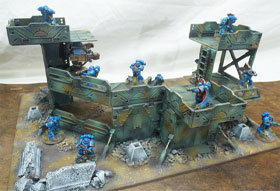
Gaming terrain & scenery foam

For tabletop model gamers, playing in the correct space is a massive part of the experience. Many play on a dedicated table or area, or even the dining room table, but building your own custom terrain and model sets personalises the game and enhances the overall experience.
Games like Warhammer 40k are typically played with wargaming terrain, although it doesn’t come as a cheap investment for pre-made sets and models. This is where foam can help provide players on all budgets with a low-cost, high-quality solution that can be customised to specification.
Model gamers use foam and various precision cutting tools – whether at home or cut to size from a factory – to make a range of landscapes and components, including model weapons, foam armatures, trees and bushes, buildings and more. However, it’s not just gamers who are doing so – model railway enthusiasts also use foam in the same way, creating custom model railroad layouts and creating beautiful sets.
To create brilliant landscapes, high-density polyethylene foam can be ordered – either as a foam sheet that will be carved into or as multiple flat sheets that can be layered with all-purpose adhesive to create complex shapes. Generally, creating a custom landscape will require foam sheets (or foam components cut to size), all-purpose adhesive, sand or dirt, a craft knife and water-based paint to create the finer details.

To create rocky, hilly terrain, layer five or six different sizes of polyethylene foam sheets on top of one another and glue them together using adhesive. Once dry, use a sharp craft knife to start cutting into the edges of the foam to make jagged edges and enhance the hill shapes. Cut irregular shapes and narrow crests, but ensure that your base pieces are bigger and your smaller pieces are layered on top to create a realistic landscape – in other words, no upside-down hills!
Cover your foam piece in PVA or all-purpose adhesive glue and apply sand or dirt as you wish to create a realistic added texture. Ensure to get in all the cracks and crevices for a natural effect. Once the glue is dry, spray paint to cover the entire piece – perhaps a mix of black, brown and green to create a rocky grass landscape – and leave to dry. This process can be repeated until the desired outcome is created.
Foam can also be used for other creations, such as model homes, figurines, and other props. For example, foam can be cut to any shape or size using our online cut to size tool should you decide not to carve your foam piece by hand. Using very-high density flat sheets, houses and outdoor huts can be created by simply tracing, cutting out, and glueing foam components together. Using a combination of spray paints, water-based paints, and other materials, these can be made to look weathered.
To create multiple template props at once, thin foam sheets can be ordered and layered on top of one another. Use a pencil to outline your intended shape (the smaller the shape, the more difficult it will be to cut and carve) and used a long-bodied craft knife to cut multiple duplicates in one go. Typically cutting three or so pieces at once is possible, although more complex and smaller shapes should be cut individually.
Please contact us for personal guidance on how foam can be used to create fantastic gaming or model village sets.

